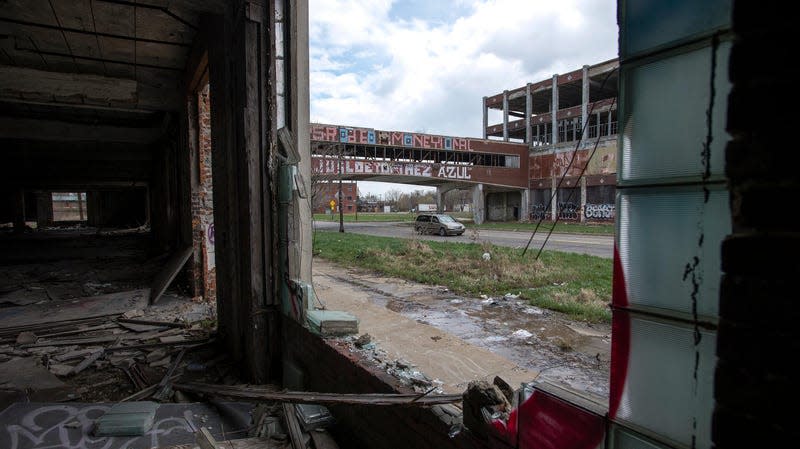Packard Auto Plant Is the Largest Abandoned Factory in the World. It's Finally Coming Down

A van drives under the bridge that crosses East Grand Boulevard connecting sections of the abandoned Packard auto assembly plant in Detroit, Michigan, U.S., on Tuesday, April 21, 2015. That bridge later fell into the street in 2019.
The gigantic Packard Auto Plant has been a 3,500,000-square-foot cancer in the heart of Detroit’s Eastside since the brand shuttered the facility in 1956 — two years before the brand would also disappear. After decades of neglect, the looming ruin is finally coming down.
Frequently cited as the largest abandoned factory in the world, crews started on phase II of the plant’s demolition Tuesday by taking down two parcels of the plant that have belonged to the city for a few years. The first section came down in September on 6199 Concord St. — considered one of the most dangerous and dilapidated parts of the abandoned site.
Read more
The city seized the rest of the abandoned factory from perpetually absent owner Peruvian investor Fernando Palazuelo, who failed to pay back taxes or do basic maintenance to secure or improve the site. A court order gave Palazuelo 90 days to demolish the site back in April 2022, after it was deemed dangerous to the general public. Palazuelo had 90 days to clean up the site. When he failed to comply with the court order — or, indeed, even appear in front of a judge — demolition duty fell to the city. Detroit Mayor Mike Duggan vowed Palazuelo will pay for the multi-million dollar project. From the Detroit News:
“He is under court order to pay for this,” Duggan said. “We’ll certainly go after every asset he has in America and if we figure out how to go after his assets in Peru, we’re going do that too. We have a clear legal strategy. You’ve probably gathered by now, this didn’t happen by coincidence. He fought every step of the way. He broke every single promise. … I’m pretty confident the courts will continue to back us up.”
When the Albert Kahn-designed plant open in 1903, it was the largest and most technologically advanced automotive plant in the world. Almost immediately the factory was expanded until it stretched for an astonishing 80 buildings cover 80 acres on city’s Eastside. Packards were considered innovative luxury vehicles in the brand’s heyday. The Packard Plant also built engines for P-51 Mustang fighter planes during World War II. Packard fell out of favor when it diluted the brand with more pedestrian, middle class cars during the Great Depression. Packard resisted getting swallowed up by the bigger brands, but it couldn’t survive when the Big Three began a price cutting war in the ’50s. Packard bowed out of history for good in 1958.
After Packard left, dozens of smaller companies took over portions of the site and operated up until the ’90s, when it was shuttered for good. The Packard became a favorite haunt for urban explorers and blight junkies despite the obvious and unbelievable danger of the crumbling ruin. There was even once a tongue-in-cheek website devoted to alerting citizens as to whether or not the plant was currently on fire. It was left to rot more or less for the last 30 years. When the famed Packard Plant bridge collapsed on to a public street in 2019 city officials began to take a harder stance on the blighted site.
What will replace the ruined factory? It’s hard to say. The neighborhoods surrounding the plant have been severely impacted by having 35-acres of blight in their neighborhood. Though the site is not far from GM’s EV production plant, Hamtramck-Detroit Assembly. Maybe GM could finally snatch up a piece of Packard for cheap.
Detroit has no shortage of empty factories from the city’s heyday as an automotive production mega hub. The 1.5-million-square-foot AMC headquarters is also slated for demolition, and you can find lots of smaller derelict buildings giving way to new structures and housing. It’s not all destruction, however. The former site of Fisher Body Plant No. 21 is under development to become a mixed-use housing project, according to the Detroit Free Press.
More from Jalopnik
Sign up for Jalopnik's Newsletter. For the latest news, Facebook, Twitter and Instagram.

